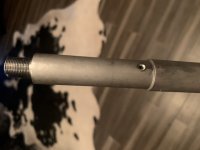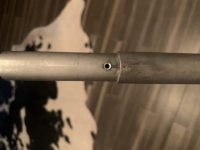First off, while Im not new to reading forums, this is my first post so thank you for taking the time to read it. Any replies will be greatly appreciated.
Let's get started here. I built an AR pistol and I will give as much detail as possible in order to determine the problem here. From the muzzle to the brace, here is what I have used for the build.
Muzzle diverter: Midwest industries
Barrel: Ballistic Advantage, 10.3 in, 1/7 twist, 5.56 caliber. No dimpling for set screws. Government profile, .750 diameter
Gas block and Tube: Both CMMG, carbine length. Gas block is not adjustable
Upper and Lower: both Wilson Combat, just standard forged receivers, not billet or anything special
BCG: CMMG, standard M16 not AR-15. (we will get to this part later however)
Buffer/Spring/Weight: Both carbine and h2 weight used, standard carbine spring, carbine buffer tube. Sba3 brace used if curious
Heres the issue im having. My pistol is short stroking, and I can't quite determine why. I have done the following for testing: I have fired both 50 gr, 55 gr, and 77 gr .223, NOT 5.56 (yes, I understand there is a pressure difference). The pistol will barely spit out the 50 and 55 grain Fiocchi vmax, not picking up the next round. The 77 gr American eagle will throw it at about the 5 o clock position, short stroking, is usually but not always picking up the next round, working about 70% of the time. For the buffer weight, I started off with a H2 thinking a pistol would be blowing brass out of the water, but I was incorrect. I then threw in a carbine buffer, it has helped but still not even close to acceptable reliability. I then test the BCG, firing both the brand new CMMG M16 bolt which did not work, and then threw in a very broken in but totally functional AR-15 bolt, this did not help either as its still short stroking with both. Yes, I did make sure the gas rings are properly aligned and in good shape, AR bolt rings are worn in but still very functional. I also did make sure the gas key is properly torqued down and screwed in, not loose or in poor shape. I next fired the pistol with the muzzle diverter both on and off, no effect on reliability. Lastly is the gas block, and here's where the problem has to lay. While I did make sure the gas block is properly aligned, there are no dimples in the barrel to make completely sure. But after firing, I did take off the gas block to inspect the inside and here are my clues. The inside of the gas block after just 10 rounds fired is very fouled with a wet-ish rust color. The set screws were properly torqued down, but my gas block still has to be leaking due to how much fouling there is. No, I did not grease or oil the barrel or block, so why the fouling is rust colored and wet-ish i'm not sure. How can this leaking be fixed if its the issue? Should I open the barrels port diameter, or seal the gas block manually? Can you do it with blue loctite until the carbon seals it, or is there a product that physically seals off a gas block? Im willing to try a lot of things that are legitimate to make sure it's sealed and not losing gas. Last point of notes here. I did take it to my gunsmith that I work with (same store we work at) and he said simply the gas block was off center and fired .223 just fine. I think he only fired a couple rounds and was specifically the 77 grain because it sorta worked with it, but then 50 and 55 grain didn't even attempted to pick up another round. Now yes, I understand 5.56 would probably work great especially since it would have higher pressures, but two things. One, due to the ammo shortage as we all know, I cannot acquire any at the moment to test the theory, I have plenty of .223 but that's it. Next, while I understand it would probably fire great, I don't care. I want this gun to cycle .223 reliably and I don't care if it's over gassed and I don't care what grain the round is, this gun needs to be reliable with any ammo I throw in it. Thank you very much for the read and I look forward to any replies.
Let's get started here. I built an AR pistol and I will give as much detail as possible in order to determine the problem here. From the muzzle to the brace, here is what I have used for the build.
Muzzle diverter: Midwest industries
Barrel: Ballistic Advantage, 10.3 in, 1/7 twist, 5.56 caliber. No dimpling for set screws. Government profile, .750 diameter
Gas block and Tube: Both CMMG, carbine length. Gas block is not adjustable
Upper and Lower: both Wilson Combat, just standard forged receivers, not billet or anything special
BCG: CMMG, standard M16 not AR-15. (we will get to this part later however)
Buffer/Spring/Weight: Both carbine and h2 weight used, standard carbine spring, carbine buffer tube. Sba3 brace used if curious
Heres the issue im having. My pistol is short stroking, and I can't quite determine why. I have done the following for testing: I have fired both 50 gr, 55 gr, and 77 gr .223, NOT 5.56 (yes, I understand there is a pressure difference). The pistol will barely spit out the 50 and 55 grain Fiocchi vmax, not picking up the next round. The 77 gr American eagle will throw it at about the 5 o clock position, short stroking, is usually but not always picking up the next round, working about 70% of the time. For the buffer weight, I started off with a H2 thinking a pistol would be blowing brass out of the water, but I was incorrect. I then threw in a carbine buffer, it has helped but still not even close to acceptable reliability. I then test the BCG, firing both the brand new CMMG M16 bolt which did not work, and then threw in a very broken in but totally functional AR-15 bolt, this did not help either as its still short stroking with both. Yes, I did make sure the gas rings are properly aligned and in good shape, AR bolt rings are worn in but still very functional. I also did make sure the gas key is properly torqued down and screwed in, not loose or in poor shape. I next fired the pistol with the muzzle diverter both on and off, no effect on reliability. Lastly is the gas block, and here's where the problem has to lay. While I did make sure the gas block is properly aligned, there are no dimples in the barrel to make completely sure. But after firing, I did take off the gas block to inspect the inside and here are my clues. The inside of the gas block after just 10 rounds fired is very fouled with a wet-ish rust color. The set screws were properly torqued down, but my gas block still has to be leaking due to how much fouling there is. No, I did not grease or oil the barrel or block, so why the fouling is rust colored and wet-ish i'm not sure. How can this leaking be fixed if its the issue? Should I open the barrels port diameter, or seal the gas block manually? Can you do it with blue loctite until the carbon seals it, or is there a product that physically seals off a gas block? Im willing to try a lot of things that are legitimate to make sure it's sealed and not losing gas. Last point of notes here. I did take it to my gunsmith that I work with (same store we work at) and he said simply the gas block was off center and fired .223 just fine. I think he only fired a couple rounds and was specifically the 77 grain because it sorta worked with it, but then 50 and 55 grain didn't even attempted to pick up another round. Now yes, I understand 5.56 would probably work great especially since it would have higher pressures, but two things. One, due to the ammo shortage as we all know, I cannot acquire any at the moment to test the theory, I have plenty of .223 but that's it. Next, while I understand it would probably fire great, I don't care. I want this gun to cycle .223 reliably and I don't care if it's over gassed and I don't care what grain the round is, this gun needs to be reliable with any ammo I throw in it. Thank you very much for the read and I look forward to any replies.




